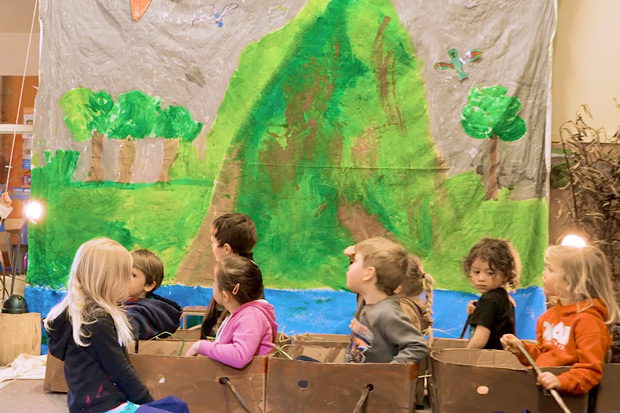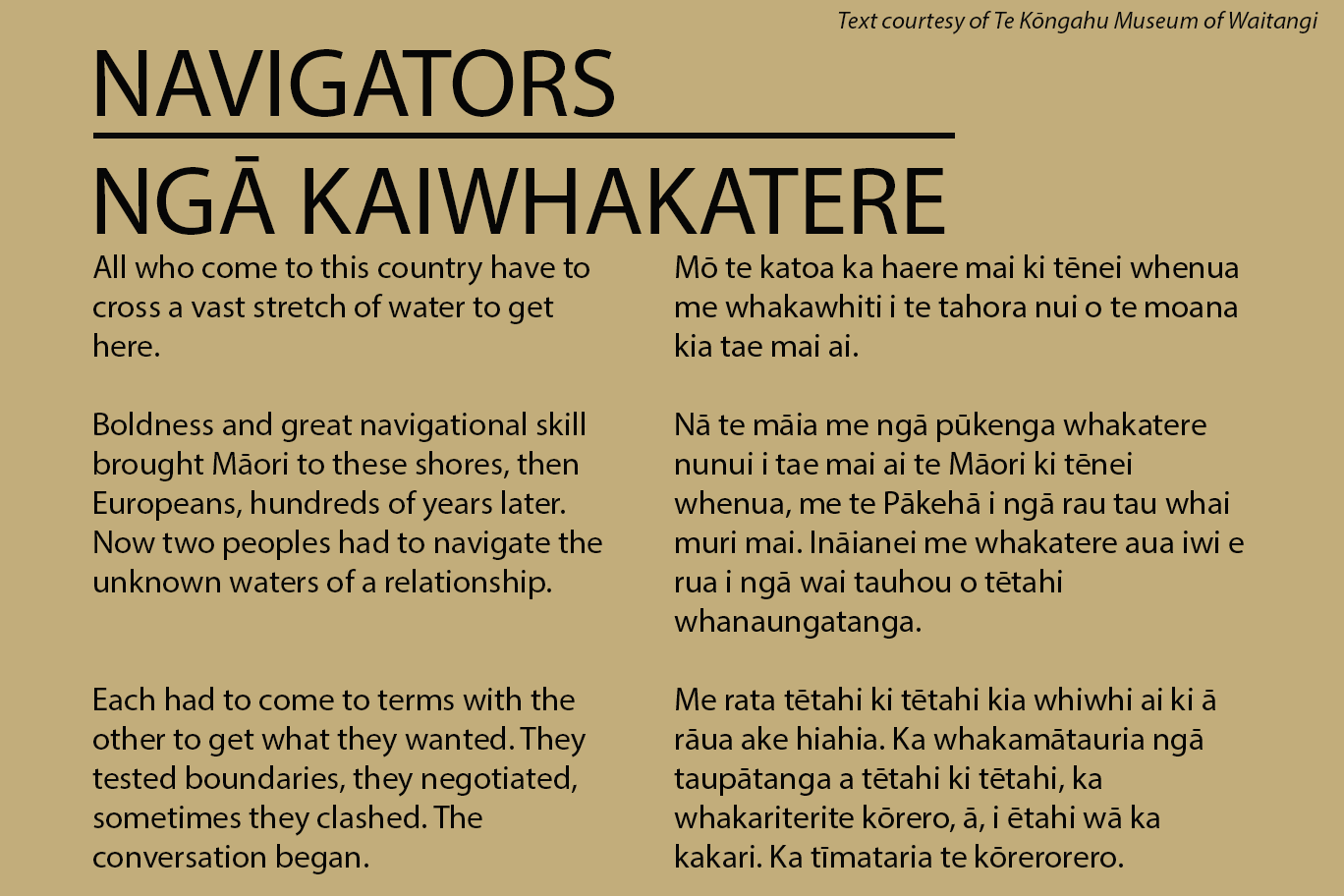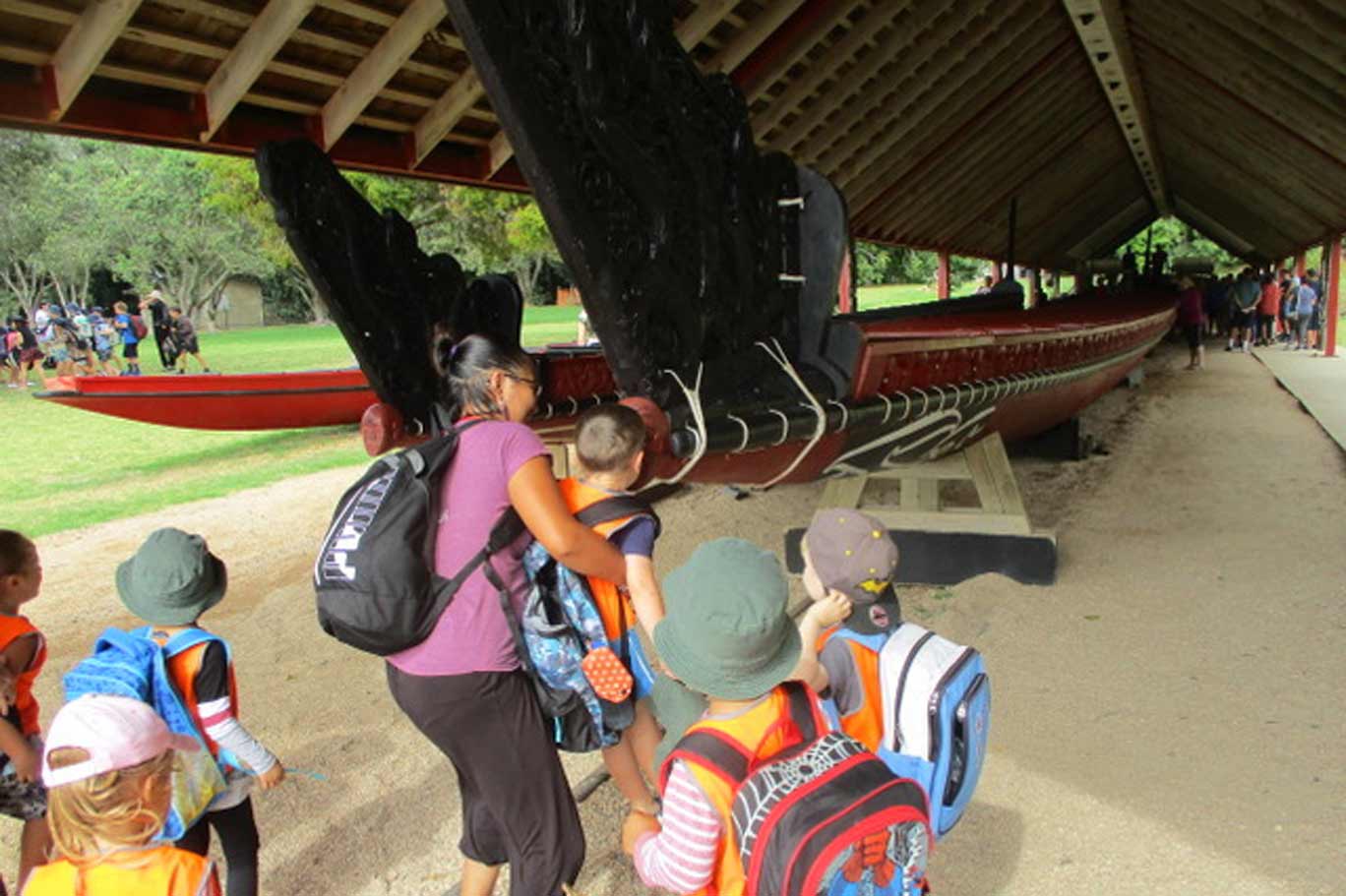Tuia Mātauranga and local histories
Tuia te here tangata
Making meaningful connections
2019 marked 250 years since the first onshore meetings between Māori and non-Māori. Tuia – Encounters 250 (Tuia 250) were the national commemorations that recognised this milestone in our history. The themes have value beyond the commemorations.
Te Whāriki is a bicultural curriculum based on the partnership established between Māori and the Crown by Te Tiriti o Waitangi (as expressed in the Te Whāriki foreword). Tuia Mātauranga presented an opportunity for kaiako to explore deeper understanding of Te Tiriti o Waitangi principles and the bicultural underpinnings of Te Whāriki
Children and young people were a key focus of Tuia 250. The national Tuia Mātauranga education programme invited kaiako and learners to develop their knowledge of their whakapapa and identity by exploring local history, including the stories of who they are and where they came from.
The video below describes how children from Kidsfirst Kindergartens Lyttelton learn about the great Māori navigator Tamatea Pōkai Whenua.
-
Transcript
(Kaiako Cathy Wall talking to the camera)
CATHY: My name is Cathy Wall. I work at Kidsfirst Kindergarten.
(Exterior and interior of kindergarten)
(Ships in Lyttelton Port)
We are in Lyttelton which is in Te Waipounamu, the South Island, and we're in a busy port town.
Tamatea Pōkai Whenua is a Māori adventurer from the 1300s who travelled around Aotearoa.
(Tamariki sitting inside their kindergarten)
We were first introduced to this story by a colleague who created a book about his adventures in Whakaraupō/Lyttelton Harbour. So there are several different versions out there about Tamatea’s adventure.
(Tamariki acting out the story of Tamatea)
We were able to consult with our local iwi and really make sure that we were doing the version of the pakiwaitara that they were happy with.
Initially we started with the picture book. Once they had started to retell the story themselves with the picture book we moved on to making a model of Te Poho o Tamatea, which is the maunga/the mountain in the story. They then used this model along with props to retell the story. Then we noticed that they were taking elements and concepts from this pakiwaitara and using it in their own play. We wanted them to really think about what it would have felt like to be Tamatea and his whānau out on Whakaraupō.
(Tamariki in their cardboard waka reenacting the story)
So we supported them to reenact the story and to make a backdrop and resources that they needed. So they are now retelling the story through drama.
(Tamariki moving black silhouettes on a light box and using figures on a felt board)
Some of the resources we’ve created have included silhouettes that we've used on overhead projectors and on lightboxes. Our children are now at the point where they know this pakiwaitara so well that they can even make and illustrate their own books.
(Three tamariki sitting on a couch, with a child showing her book to the other two tamariki)
We have one child who has retold me the whole story and then done all the illustrations and she now shares that book with her peers and her whānau. She's very proud of herself.
(Kaiako Cathy Wall talking to the camera)
So her being able to tell this story and create the book tells me that she has a very in-depth understanding about this pakiwaitara and how it affects people around them in her own whānau. She's added elements on that really are important to her.
(Tamariki watching the reenactment)
Most of the tamariki were involved in the reenactment but some were still observing so we wanted to ensure that these children had another means of retelling a story and deepening their understanding.
(A child using a storytelling app and moving around the figures in the story)
We introduced a storytelling app that they were able to use quietly by themselves to really express what they understood. Then we were able to share this digital platform with peers and whānau.
(Children using clay and drawing with crayons)
The children also use paintings, drawing utensils, and clay to represent their understandings.
(Artwork hung throughout the kindergarten)
We've made books and we celebrate all their artwork throughout the kindergarten. So this really in-depth look at this one pakiwaitara has given the children the opportunity to really explore their understanding.
(Tamariki acting out the story during the reenactment and outside play)
They think a lot and talk a lot about what it would have been like to live in Aotearoa hundreds of years ago. What the clothing would have been like, what food would have been like, what the means of transport were, even what the family structure was like. We've really been able to explore the story and unpack it with them.
(Whakaraupō/Lyttelton Harbour with the traffic going past)
We’ve now discovered that the children are going home and telling their whānau members about Tamatea – where he's been and what his adventures have included and also where our landmarks in our local community have come from. As kaiako we have really come to understand how important it is for children to value their place in the community and have a feeling of belonging. Through this pakiwaitara they've been able to have an understanding of this and make links with the local landforms, the local iwi, just the whole local community. That's really strengthened their sense of identity.
See more about the story of Tamatea Pōkai Whenua in the Examples of designing local curriculum using Tuia Mātauranga below.
Tuia Mātauranga teaching and learning guides
Download the four guides that weave together Te Whāriki strands, goals, learning outcomes, and this kaupapa.
The four PDF guides include inquiry questions for the four Tuia 250 topics and ideas on how these could be explored in your service.
- Voyaging early learning teaching and learning guide 11 pages (600KB)
- First Encounters early learning teaching and learning guide 11 pages (850KB)
- New Zealand History early learning teaching and learning guide 11 pages (620KB)
- Legacy of Learning early learning teaching and learning guide 10 pages (360KB)

The passage below greets visitors at the entrance to Te Kōngahu Museum of Waitangi. It speaks of journeys to Aotearoa, meetings, and the beginnings of conversations that continue today.

Tuia Mātauranga
Tuia 250 was an opportunity to hold honest conversations about the past, the present, and how we navigate our shared future together. Beyond Tuia 250 we can continue to speak openly and respectfully about our history, its impact on our people, and the environment. We can reflect on the challenges we face as a nation committed to bicultural practices: how we can enable our diverse cultures to flourish in a shared future that we will be proud to leave for generations to come.
Tuia Mātauranga aimed to inspire kaiako, children, and whānau to explore their own stories of who they are and where they come from – to develop their knowledge of whakapapa and identity.
The following examples illustrate how Kidsfirst Kindergartens Lyttelton and Te Waenganui Childcare Centre have applied elements of Tuia Mātauranga in designing focus areas for a local curriculum.
Examples of designing local curriculum using Tuia Mātauranga
Learning local history and pakiwaitara
Key points
- Teaching local pakiwaitara over time
- Incorporating drama and digital technologies
At Kidsfirst Kindergartens Lyttelton the children learn about the great Māori navigator Tamatea Pōkai Whenua. He explored Aotearoa from the far north to the deep south in the 1300s. Tamatea was responsible for naming Whakaraupō (Lyttelton Harbour). The cone-shaped hill that rises in the landscape behind Rāpaki also bears his name – Te Poho o Tamatea.
There is a well-known local pakiwaitara about Tamatea, which generations have told to explain unusual landforms and special features of the district.
Over time, kaiako interest in this local history has led to respectful relationships with people in the community, and the sharing of this pakiwaitara in book form. Kaiako immediately saw the interest this pakiwaitara sparked in children. It is now a significant part of the curriculum, told and retold in many different ways, as illustrated in the presentation below.
Tamatea Pōkai Whenua pakiwaitara
-
Transcript
Tamatea Pōkai Whenua sailed into Whakaraupō in his waka with his whānau and friends.
They were looking for a place to rest and were enjoying the beautiful, calm, and sunny day.
At the front of the waka was Tamatea’s toka ahi which was used to create fire at each of their stops.
After some time the weather began to change. It started to drizzle and Tangaroa sent some big waves their way.
Before long the rain got heavier and the waves got bigger.
The waka rocked from side to side and the toka ahi fell out and into the moana.
Tamatea and his whānau fought against the storm.
Finally they were able to pull the waka up onto the beach at Rāpaki.
But they were makariri and hungry. Kei te matekai ia.
The days went by and Tamatea saw his whānau and friends becoming ill and unhappy.
He decided something must be done.
Tamatea climbed te maunga nui behind the beach.
When he got to the top, he called to the atua to send him some fire, “Homai te ahi tapu!”
The atua heard him and sent a fireball through the air.
A little bit of fire fell off at Maruia Springs and a little bit dropped off at Hanmer Springs before landing on the beach at Rāpaki.
Tamatea and his whānau were overjoyed.
They were able to build a fire and keep warm. And they were able to cook their kai.
From then on te maunga nui behind Rāpaki has been known as Te Poho o Tamatea.
Kaiako believe that history comes to life for children when it is connected to the landmarks and places children know. They hear that children talk about Tamatea Pōkai Whenua when they are out and about with their families. The children’s knowledge helps build their sense of identity and place.
Kaiako refer to Tamatea in other ways too. Dispositions associated with Tamatea’s character – pakari, māia, mātua, and kaiarataki – are part of the everyday language in the kindergarten. These dispositions incorporate courage, determination, and leadership. As one kaiako explains, “I feel they (the children) know him so well; they almost feel connected to him.”
What contributed to success here?
Kaiako who:
- prioritise their obligations to Te Tiriti in their teaching practice
- value relationships and connections in their rohe as a source of rich learning
- factor into their curriculum design that deep learning comes from repetition over time
- are knowledgeable and reflective to the development of children’s learning dispositions that are valued by Māori
- closely observe children's engagement to create new learning opportunities that take account of their interests.
Tuia Mātauranga – a provocation for thinking differently about local curriculum planning
Key points
- Community professional learning and development as a springboard for local curriculum
- Curriculum design utilising local resources and experience
The kaiako at Te Waenganui Childcare Centre in the Bay of Islands were looking for ways to deepen children’s learning. In Tuia Mātauranga they found a resource that supports them to do this.
Kaiako first learnt of Tuia Mātauranga when they accepted a meeting invitation sent to local schools and early learning services. During the meeting, kaiako were given a sheet of inquiry-based learning questions to inspire conversations and learning on the four Tuia 250 topics:
- Voyaging
- First Encounters
- New Zealand History
- Legacy of Learning
Sensing that many of the questions could help them achieve the goals and learning outcomes in Te Whāriki, kaiako applied them as provocations in local curriculum planning.
Questions such as, “Why do we make agreements?” took kaiako in directions they wouldn’t have otherwise gone and encouraged them to draw on resources unique to their location. The result was more engaged learning for children and more opportunities to involve the local community.
For example, the centre’s proximity to the Waitangi treaty grounds meant the children were already familiar with Ngātokimatawhaorua, the waka housed there. However, the inquiry question “What would early voyagers need to think about for the voyage to Aotearoa/New Zealand?” led them into investigating how food was caught, kept, and carried by the first Māori navigators.

Image: A child engages in hongi with Ngātokimatawhaorua at the Waitangi treaty grounds.
Te Waenganui Childcare Centre serves a seaside and boating community. Kaiako were inspired by the topics and themes in Tuia Mātauranga. Their local curriculum planning enabled them to work more deeply with the interests and lived experiences of the children and whānau.
What contributed to success here?
Kaiako who:
- see it as their responsibility to enact Te Tiriti within their curriculum for all children
- look outwards and approach a new opportunity with openness and curiosity
- are confident in local curriculum design, including adapting resources to suit their location and learners’ age and capability.
Tuia Mātauranga in your context
Using Tuia Mātauranga ideas and resources is an opportunity for similar conversations and practice to emerge in your early learning service.
Remember to:
- reach out to members of your community and explore local facilities to learn about the local history and stories of your rohe
- use Tuia Mātauranga themes and topics as you brainstorm possible lines of direction for your local curriculum
- use the Tuia Mātauranga PDF resources for suggestions and ideas
- imagine planning as a process of deepening learning over time where you return to ideas, experiences, and concepts in different ways.
Tuia Mātauranga has strong connections with each of the principles and strands of Te Whāriki.
Refer to the goals and learning outcomes to prioritise and guide your exploration of the Tuia Mātauranga topics and themes. Making good use of learning outcomes will help you with this.
Drawing on Tuia Mātauranga will also support you in enacting the responsibilities of kaiako outlined in Te Whāriki. For example, an in-depth curriculum investigation of any of the themes is an opportunity for kaiako to:
- develop further cultural competence
- integrate domain knowledge
- be role models for languages and learning
- interpret theories that underpin effective pedagogy in Te Whāriki, its framework, and intent.
Learning maps for the Tuia 250 topics from early learning through to year 10 are available on Social Sciences Online:
-
Useful resources
Voyaging
He Kōrero Pūrākau Mo Ngā Taunahanahatanga a Ngā Tūpuna, Place names of the ancestors: A Māori oral history atlas
This book is a useful resource for those seeking information on Māori navigation and navigators.
Find the PDF online at Toitū Te Whenua, Land Information New Zealand: He Kōrero Pūrākau Mo Ngā Taunahanahatanga a Ngā Tūpuna.
Download the full PDF: He Kōrero Pūrākau Mo Ngā Taunahanahatanga a Ngā Tūpuna
First Encounters
Let’s be honest – Jenny Shipley
In this video the national coordinating co-chair of Tuia 250 discusses the purpose of marking the first meeting of Māori and non-Māori.
New Zealand History
National Library pūrākau resources
This resource has links to videos, images, websites, and articles of Māori pūrākau.
Te Ara – The Encyclopaedia of New Zealand
Te Ara is an online reference for information on the people, environment, history, culture, and society of Aotearoa New Zealand.
Provides information and resources for educators that could be adapted for use in early learning services.
Legacy of Learning
Bicultural nature of Te Whāriki
Dr Lesley Rameka video presentation on the bicultural perspective of the revised Te Whāriki curriculum.
Māori educationalist Professor Wally Penetito shares his views on the value of place-based curriculum in retaining knowledge of local history and tikanga, as well as challenging taken-for-granted world views.
Tuia 250 an opportunity to share stories
In this video Dr Wayne Ngata, a former teacher and noted te reo Māori specialist, says Tuia 250 is an opportunity to highlight stories of Aotearoa New Zealand. He encourages the use of storytelling as a way to expand understanding of our past.
Wayfinding leadership: Wisdom for developing potential
In this TEDx talk Chellie Spiller talks about leadership, drawing inspiration from early Māori navigators.
